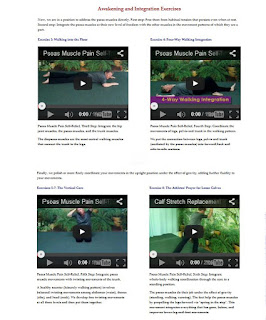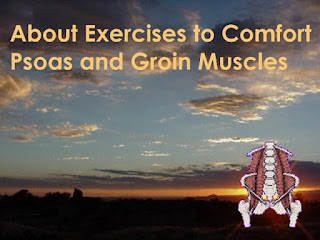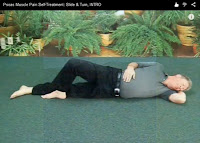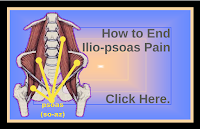 Your Psoas Muscles — Healthy and Unhealthy — How to Get Your Psoas Muscles Healthy, Again
Your Psoas Muscles — Healthy and Unhealthy — How to Get Your Psoas Muscles Healthy, Again
The psoas muscles are easy to understand when you consider the basic movements in which they are involved: sitting, standing, and walking — and how those movements are controlled: movement (muscle) memory.
This article explains healthy and unhealthy psoas muscle functioning and how to get your psoas muscles healthy, again.
What Your Psoas Muscles Do
When functioning right, your psoas muscles maintain your uprightness in sitting, your spinal alignment and balanced equilibrium when standing, and your efficiency of movement bending, twisting, walking and running. Your psoas muscles are core stabilizers that lend balance to movement.
 Tight psoas muscles show up as groin pain, deep pelvic pain, and as a deep belly ache.
Tight psoas muscles show up as groin pain, deep pelvic pain, and as a deep belly ache.
Postural effects include a butt that sticks out too much, in back, and a protruding belly, as pelvic position shifts top-forward.
Leg movement is restricted, in walking, in their freedom to move backward; tight hamstrings often develop to compensate for the extra drag.
Awkwardness and poor balance result. Chronic constipation also develops, in some people, due to the effect of an overactive psoas on the neighboring nerve plexus that regulates intestinal activity.
To Free Tight Psoas Muscles
Three basic approaches exist. One is much more effective than the others.
- stretching
- massage/manipulation
- movement training
First basic understanding: Muscle/movement memory controls your psoas muscles.
If your psoas muscles are tight, your muscle/movement memory keeps them that way. Muscle/movement memory comes from a deeper level of the nervous system than voluntary movement does; it’s conditioning that “runs the show”.
 You can’t stretch or manipulate away conditioning; you can’t stretch or manipulate away muscle/movement memory. Because muscle/movement memory develops by conditioning, stretching and manipulation produce, at best, temporary and partial results.
You can’t stretch or manipulate away conditioning; you can’t stretch or manipulate away muscle/movement memory. Because muscle/movement memory develops by conditioning, stretching and manipulation produce, at best, temporary and partial results.
The pattern of remembered movement and tension quickly returns. That understanding explains your experience with therapy for tight psoas muscles.
Since muscle/movement memory runs the show, you need an approach that re-conditions muscle/movement memory — and that’s where movement education comes in.
Movement education isn’t “knowing how to move” or “maintaining good posture”. It’s developing new patterns of coordination by actions that reach the depth at which movement/memory lives — the kind of movement memory involved in riding a bicycle, for example. How did you learn to ride a bicycle (or swim, for that matter)? Practice: development of new patterns of movement until they become habitual.
The development of new control and new movement involves not just freeing muscles, but
also integrating them into movement patterns with other movers and stabilizers of the body. Movement training also involves awakening our ability to sense the actions of our muscles in movement and balance.Without the integration step, your psoas muscles are likely to revert to their tight state. I’ll say more, as we go on.
Understanding how psoas muscles play in movement simplifies our approach to setting things right. Having made such a statement, I will, of course support it. But first, I have to lay some groundwork.
“PSOAS” OR “ILIOPSOAS”?
 The psoas muscles share a tendon with the iliacus muscles, which line the inside of the pelvis, so the combination is called, the “iliopsoas” muscle. For brevity, I use the term, “psoas muscle”.
The psoas muscles share a tendon with the iliacus muscles, which line the inside of the pelvis, so the combination is called, the “iliopsoas” muscle. For brevity, I use the term, “psoas muscle”.
CORE MUSCLES
The psoas muscles are our deepest core muscles.

When people speak of the “core”, they usually mean the muscles of the abdominal wall. But how is that the “core”? The core of anything, such as the Earth or an apple, is its centermost part. The psoas is a core muscle (as are the diaphragm, quadratus lumborum, iliacus and other muscles closest to bone); the abdominal muscles are “sleeve”, outside
the core.
HOW PSOAS MUSCLES FUNCTION AS CORE MUSCLES
The psoas muscles, being most centrally located as the deepest muscles in the body, help control the shape of the spine. By controlling the shape of the spine, they control our balance — how the centers of gravity of our major segments – head, thorax (or chest), abdomen and legs – line up.
Tight psoas muscles distort the spinal curves, shorten the spine, change pelvic balance and cause ungainly (chunky, heavy, labored, awkward) movement. To the degree that the spinal curves are distorted, our alignment is distorted and to that degree, we are out of balance and our movement is un-economical/wasteful of effort.
THE PSOAS MUSCLES COORDINATE WITH OTHER MUSCLES THROUGH MOVEMENT (MUSCLE) MEMORY
Muscles never work alone; they always work in concert with other muscles. What
any muscle does affects our entire balance. Other muscles have to compensate for those effects on balance by tightening or relaxing. Your brain controls these entire patterns of movement and compensation with memories of movement (“muscle/movement memory”).
Because your nervous system and muscular system cooperate as a whole, to try to change the movement and tension behavior of tight psoas muscles without changing the larger movement pattern of which they are a part is to work against the rest of the system and its (our) memory of how movements go and feel. That’s why methods of muscle manipulation (e.g., massage, myofascial release, stretching) produce changes that are either temporary or slow in coming – and why psoas release by manipulation is painful: it works directly on sore, contracted psoas muscles against the conditioning of the entire movement system.
ACTIVITY AND REST: COORDINATION AND MUSCLE TONE
The term, “tone”, refers to the level of muscle tension: complete rest means zero muscle tone; complete activation means maximum muscle tone. Some people believe that the higher the tone, the better; others believe that complete relaxation is better. As you will see, where tone is concerned, it’s neither; better-integrated is better, and
better-integrated means more freedom to adjust accurately to changing conditions — freedom and balance.
 Your brain coordinates the movements and tone of muscles; tone changes as position changes in movement. That’s what is meant by “supple.” Supple psoas muscles have the sensation of spaciousness, support, freedom and length at your body core. The term rolfers use is, “open core.” When psoas muscles do their job of stabilizing the spine, they relieve the abdominal wall muscles of some of that task; your abdominal muscles have the sensation of relaxation and free breathing. The term rolfers use is, “free sleeve.” Healthy psoas functioning gives the experience of “open core, free sleeve.” Open core/free sleeve is the feeling of trunk/spine length, flexibility and stability.
Your brain coordinates the movements and tone of muscles; tone changes as position changes in movement. That’s what is meant by “supple.” Supple psoas muscles have the sensation of spaciousness, support, freedom and length at your body core. The term rolfers use is, “open core.” When psoas muscles do their job of stabilizing the spine, they relieve the abdominal wall muscles of some of that task; your abdominal muscles have the sensation of relaxation and free breathing. The term rolfers use is, “free sleeve.” Healthy psoas functioning gives the experience of “open core, free sleeve.” Open core/free sleeve is the feeling of trunk/spine length, flexibility and stability.
HEALTHY FUNCTION
“Healthy”, in this sense means, “getting the intended result with the least effort.” Where movement is concerned, the word, “graceful”, applies. Graceful movement is economical movement; awkward movement is uneconomical or ungainly movement. Graceful movement conserves effort; ungainly movement wastes effort. For movement to be economical, it must be well-balanced and well-coordinated — a matter of integration.
Psoas muscles help regulate our changes of position as we move from rest into activity and from activity into rest by changes in their tone. They help maintain our balance and stability in those positions. They are central to movements from lying to sitting, from sitting to standing, and from standing to walking and running. If their tone is too high, they interfere with balance and stability as we move into different positions; their tone is almost never too low, and if so, usually indicates either neurological damage or a need to learn basic control.
With changes of position, the activity level of your psoas muscles changes, as follows.
From Lying Down to Sitting to Standing to Walking and Running
At rest or in repose, your psoas muscles have no job to do and should be at rest — which means relaxed and comfortable.
Your psoas muscles connect your legs to your trunk. When you move from lying to sitting, they move your pelvis and provide a sufficiently stable core as you move to the upright position. Overly tight psoas muscles create groin pain or deep low back (lumbopelvic) pain when changing position from lying to sitting. You may have the experience of a groin pull or of muscles seizing up in your pelvis.
When Sitting
Your psoas muscles connect your groin to your pelvis and low back and stabilize your balance in the front-to-back direction; your brain adjuststheir tone for the right amount of front-to-back stability under the pull of gravity.
From Sitting to Standing
As you move from sitting to upright standing, your psoas muscles must relax and lengthen to permit you to stand fully upright.
Overly tight psoas muscles, which connect your groin to your spine, prevent you from coming to a fully erect, balanced stand.
When Standing
Your psoas muscles’ well-regulated tone is low enough to allow you to stand at your full stature, with minimal lumbar curve and high enough to stabilize your core. Through your psoas muscles, your brain adjusts your spinal curves (and balance) as you bend forward, lean back, move side-to-side, and twist and turn.
Overly tight psoas muscles don’t lengthen enough as you stand straight; they pull from your groin to your low back, causing lumbopelvic or lumbosacral pain, a “pubes back”
position, and excessive lower back curve. Your belly protrudes and your butt sticks out.
From Standing to Walking
As you step into walking, you first shift your weight onto one foot to free the other leg to come forward; the psoas muscles on the standing side relax and those on the walking side tighten to help you step forward. In healthy walking, your psoas muscles freely alternate, side-to-side, between higher and lower tone as you walk or run.
Overly tight psoas muscles shorten your stride and require your hamstrings and gluteus medius muscles to work harder to bring your “standing” leg back as you step forward. You end up with tight hamstrings and tight gluteus medius muscles (hip pain in back).
You can’t make a lasting change in one without changing the other because your brain maintains habitual patterns of movement among muscles (pattern of coordination); to change one so that it functions differently, you have to reorganize the entire pattern. That kind of change doesn’t occur “by deciding to move differently” or by stretching; when you’re walking, you can’t conveniently put that kind of attention into your movements; you have to make it automatic, and there’s a process for that, mentioned below.
SUMMARY
Efforts to free the psoas muscles without also improving their coordination with the rest of
the musculature produce only partial and temporary improvements.
 That means that “psoas release” techniques, “psoas stretches”, and psoas strengthening approaches need movement education (which changes brain-conditioning of muscular control) to produce a stable shift to healthy psoas
That means that “psoas release” techniques, “psoas stretches”, and psoas strengthening approaches need movement education (which changes brain-conditioning of muscular control) to produce a stable shift to healthy psoas
functioning.
Economical movement (least effort, good result) and easy balance are the goal — attributes you can develop by movement training that first frees the psoas muscles and then integrates them into economical movement patterns. First free, then integrate.
The name for that kind of training process is, “clinical somatic education.”
RESOURCES
Overview of Free Your Psoas Program
ONCE YOU HAVE RELEASED YOUR PSOAS MUSCLES:
 Releasing your psoas muscles, by whatever means, is just the start. Integration is necessary for a satisfactory outcome to any approach to freeing muscles. The somatic education exercise program, Free Your Psoas, provides exercise (action) patterns that integrate and coordinate the psoas muscles with other stabilizing muscles of the body.
Releasing your psoas muscles, by whatever means, is just the start. Integration is necessary for a satisfactory outcome to any approach to freeing muscles. The somatic education exercise program, Free Your Psoas, provides exercise (action) patterns that integrate and coordinate the psoas muscles with other stabilizing muscles of the body.
“Once You Have Released Your Psoas Muscles” || Note the link to a preview of the full, Free Your Psoas program on that page.
Bookmark this page on Delicious.
#psoas_muscle_syndrome





